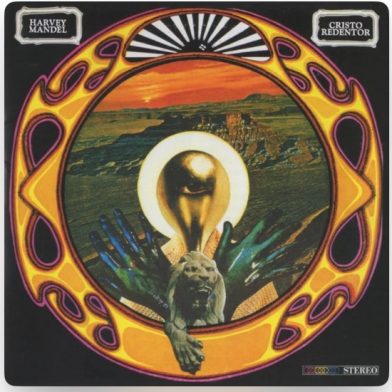
Harvey Mandel’s 1968 blues-rock solo debut Cristo Redentor is a psychedelic masterpiece of virtuoso playing and instrumental innovation.
Back in 1968 a young blues guitarist from Chicago released an album which is a mostly unheralded masterwork. The guitarist was Harvey Mandel; the album was called Cristo Redentor, and the release was instantly received by critics and guitar fans as a pyschedelic masterpiece of virtuoso playing and instrumental innovation. I‘m foolish enough to think this was faint praise, so the rest of this piece is going to seem a trifle overblown to the uninitiated. You see, I‘ve been listening to Cristo Redentor since it was released, and for me this is and always will be one of the essential guitar-based albums of the last century.
To put it bluntly, Harvey Mandel‘s playing is a staggering work of genius coming from a young veteran of the Chicago blues scene; he had no business at all delivering a masterwork so early in his career. Harvey got his start playing guitar on the legendary Charlie Musselwhite first album Stand Back!, released in 1966 when Mandel was all of 21 years old. Two short years later, he took Chicago Blues and turned it on its head with strings, horns, and an attention to arrangement detail that stands the test of time. Frankly, if Bach had played electric guitar, he might well have composed and arranged this record. Of course, Bach may have needed a little artificial stimulation to get into the groove that Harvey and his band achieve here.
Speaking of the band, The Snake (Mandel‘s nickname) was accompanied by such luminaries as his former boss Charlie Musselwhite on harmonica, Kenny Buttrey on drums, Pete Drake on steel guitar, and Nick De Caro on piano. The whole thing was recorded by an engineering staff flown in from the 22nd century. Outside of the hymnal wordless vocals on the title track, the album is an instrumental one. However, very few completely instrumental albums have ever made much of an impact on the record-buying public: Wendy Carlos‘s Switched On Bach, Mike Oldfield‘s Tubular Bells, and a couple by Vangelis and/or Tangerine Dream releases come to mind. This minor success of instrumental music covers 30 or 40 years – we North Americans love our simple tunes and familiar vocals.
The album opens with a new interpretation of an early 20th century spiritual called “Wade In The Water”; it had been recorded numerous times, notably by the British bluesman Graham Bond in 1965, and by The Ramsey Lewis Trio in 1966. It‘s the Bond version that appears to have been the inspiration for The Snake, since Graham Bond sat in on these sessions, notably on piano on “You Can‘t Tell Me”: he was a highly eclectic musician. However Mandel achieves something which is entirely his own here. Within a few bars of the opening, the listener is transported to another plane – a mix of violins, electric guitar sustain, and a hypnotic and distinctive blues guitar sound unlike any other. On headphones this track is nothing short of sensational, requiring very little in the way of ingested substances to open a few neural pathways. In other words, this is music that seizes control of your little suburban life and drags it out into the sunshine.
The title track is another standout: “Cristo Redentor” was written by a jazz musician named Duke Pearson, and was first recorded in 1963 by Donald Byrd, a noted jazz trumpeter. The song was played at the funeral of Martin Luther King, and has been featured in several films. While Byrd‘s recording is ethereally beautiful, so is Mandel‘s – incredibly so for a 23 year old blues guitarist. The accompanying wordless vocal by a group of four women is very moving. The guitar playing by Mandel is restrained, elegant, and thoughtful.
The other tunes on the album are straight-ahead blues rock with an original stereopsychotic touch. I recommend particularly “Lights Out” for its restrained but highly psychedelic feel that morphs into a brief nightmare (I mean this in a good way) then returns to some of the most tasteful guitar playing you will ever hear. Elsewhere, the Charlie Musselwhite harp rendering of an approaching train on “The Lark” is alone worth the price of admission: headphone exposure to this tune will shear the top of your head off.
The album garnered enough underground attention from guitar aficionados that Mandel was invited to join Canned Heat. Later he was invited to audition for The Rolling Stones. Brian Jones had died in 1969 and Mick Taylor had quit the Stones. Though Harvey impressed the hell out of them he didn’t join. Being in a group and letting his own virtuoso skills stand aside wasn‘t appealing, I suspect, and Mandel soon found himself on his own again. He continues to tour and record to this day.
Cristo Redentor was ahead of its time and it still sounds fresh and invigorating. The sonic purity and never-ending depth of musical invention of this record, heard on a good system (preferably vinyl-based) is nothing short of astonishing.
They say a genius always knows just how good he is. In person, Harvey is unfailingly modest but forthright in his estimation of the contribution he made to 20th century guitar music. In his own words:
“I knew where guitar was going 20 years before it got there. I knew that eventually guitar technique would equal horn players and keyboard players”.
Take a trip back to 1968 with this album with ‘The King of Sustain’ and see if you agree.

This is such a great review! Harvey Mandel makes some of the most interesting and compelling music you can hear and for some reason is not appreciated like he should be. And there is no one that can put on a live show like Harvey Mandel.
I toured with Harvey for almost 8 months. A great guitarist.